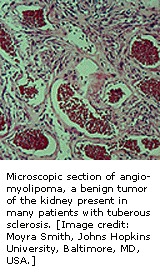NCBI Bookshelf. A service of the National Library of Medicine, National Institutes of Health.
National Center for Biotechnology Information (US). Genes and Disease [Internet]. Bethesda (MD): National Center for Biotechnology Information (US); 1998-.

Tuberous sclerosis is an hereditary disorder characterized by benign, tumor-like nodules of the brain and/or retinas, skin lesions, seizures and/or mental retardation. Patients may experience a few or all of the symptoms with varying degrees of severity.
Two genes for tuberous sclerosis have been found: TSC1 on chromosome 9, and TSC2 on chromosome 16. It took four years to pin down a specific gene from the TSC1 region of chromosome 9: in 1997, a promising candidate was found. Called hamartin by the discoverers, it is similar to a yeast protein of unknown function, and appears to act as a tumor suppressor: without TSC1, growth of cells proceeds in an unregulated fashion, resulting in tumor formation. TSC2 codes for a protein called tuberin, which, through database searches, was found to have a region of homology to a protein found in pathways that regulate the cell (GAP3, a GTPase-activation protein).
TSC1 has a homolog in yeast, which provides a system in which to model the human disease.
Related diseases
- Genome view see gene locations
- Entrez Gene collection of gene-related information
- BLink related sequences in different organisms
- Research articles online full text
- Books online books section
- OMIM catalog of human genes and disorders
- GeneReviews a medical genetics resource
- OMIMRelated OMIM records
- Tuberous sclerosis - Genes and DiseaseTuberous sclerosis - Genes and Disease
- psbM [Pyrularia edulis]psbM [Pyrularia edulis]Gene ID:54097044Gene
- petG [Pyrularia edulis]petG [Pyrularia edulis]Gene ID:54097041Gene
Your browsing activity is empty.
Activity recording is turned off.
See more...
